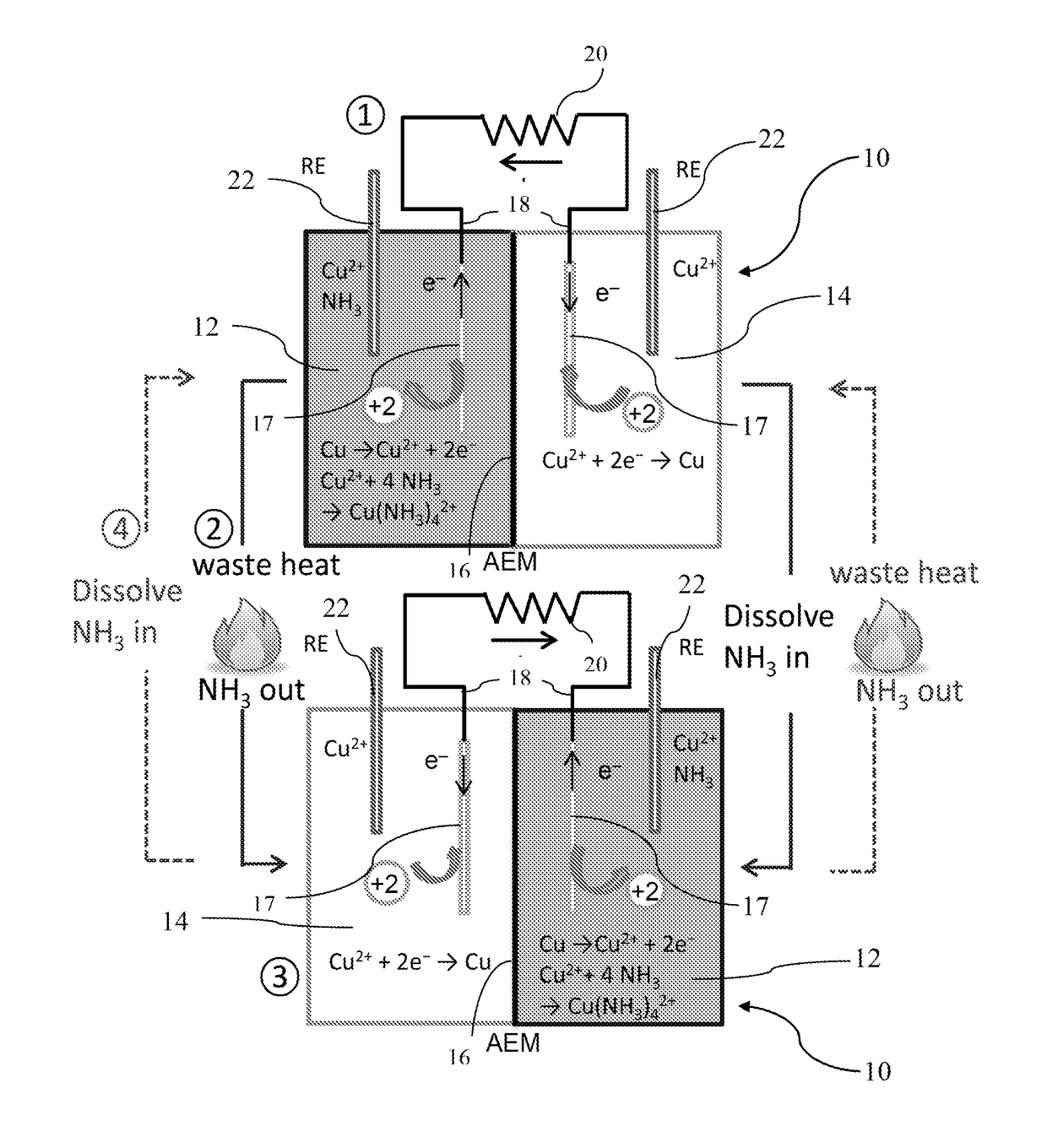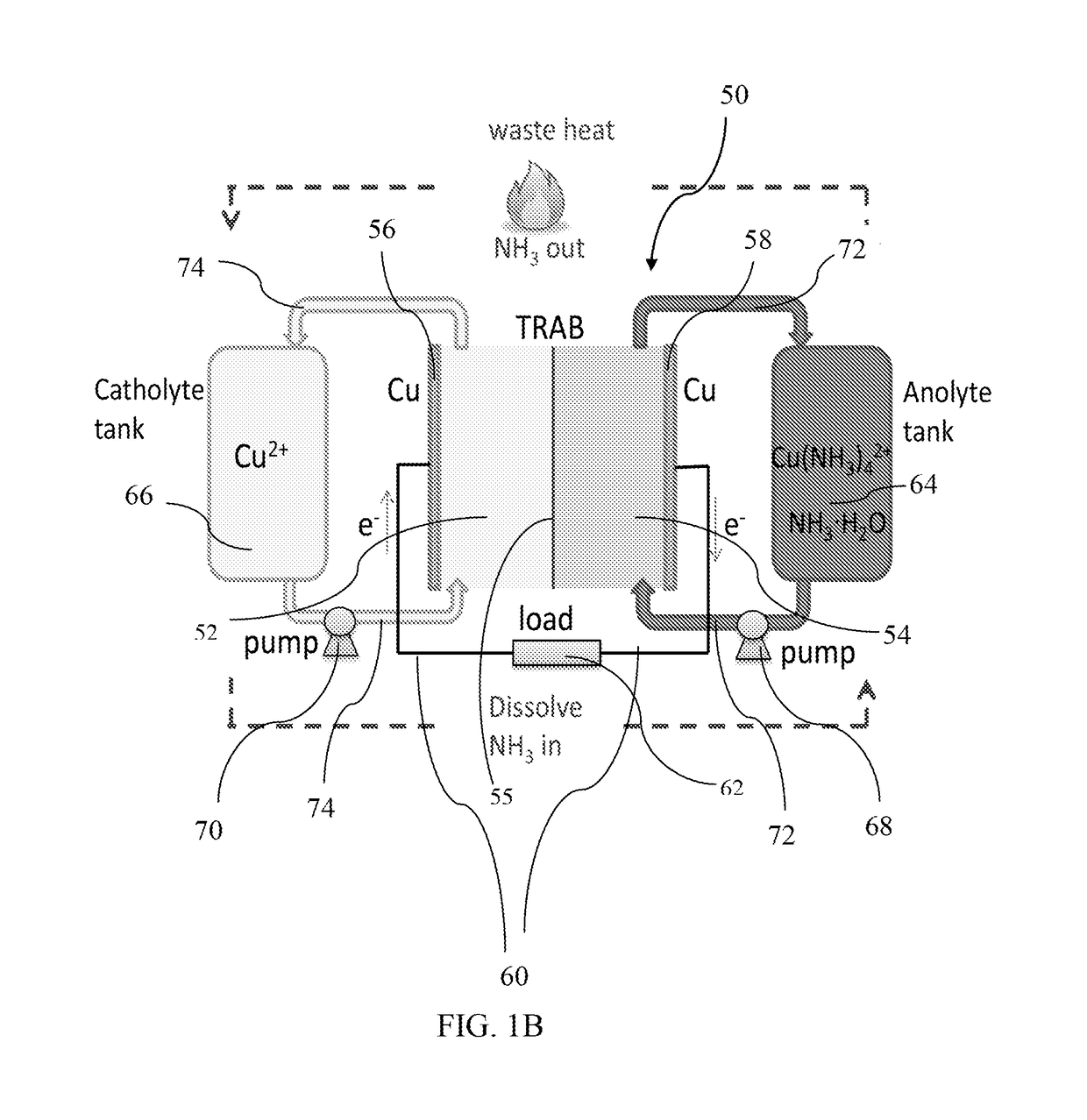Ammonia-based thermoelectrochemical systems and methods
a technology applied in the field of ammonia-based thermoelectrochemical systems and methods, can solve problems such as lack of energy storage capacity, and achieve the effect of inhibiting electrode corrosion
- Summary
- Abstract
- Description
- Claims
- Application Information
AI Technical Summary
Benefits of technology
Problems solved by technology
Method used
Image
Examples
example 1
[0143]Design, Construction, and Operation
[0144]A single TRAB cell consisted of anode and cathode chambers, 12 and 14, respectively, separated by an anion exchange membrane 16 (AEM; Selemion AMV, Asashi glass, Japan; effective surface area of 7 cm2) as shown in FIG. 1A. The two chambers 12 and 14, each 4 cm long and 3 cm in diameter, were constructed from 4-cm cubes of Lexan. The electrodes 17 were made of copper mesh (50×50 mesh, McMaster-Carr, OH; 0.8 cm×2 cm with a projected surface area of 1.6 cm2, weight of 0.2365±0.0004 g) connected using copper wires 18 to an external resistor 20. Ag / AgCl reference electrodes 22 (+211 mV versus SHE; RE-5B; BASi) were inserted at the two sides of the copper electrodes that were outside the current path to monitor the electrode potentials as shown in FIG. 1A. The cathode chamber was stirred using a stir bar (6.4×15.9 mm, magnetic egg-shaped stir bars, VWR; 500 rpm) (except as noted otherwise) while the anolyte was not mixed.
[0145]The electrolyte...
example 2
[0177]Using silver electrodes and silver nitrate electrolyte in the TRAB system produced a maximum power density of 96±7 W m-2 at room temperature, similar to that of 95±5 W m-2 with the copper system (FIG. 15A). With the silver system, both electrode potentials were more positive than those obtained with the copper system, due to the higher reduction potentials of Ag+ / Ag (E0 of 0.799 V), and Ag(NH3)2+ / Ag (E0 of 0.373 V).
example 3
[0178]The inexpensive ultra-high-molecular-weight polyethylene (UHMWPE) battery separator can be used as an alternative separator material for the TRAB. At the temperature of 50° C., the UHMWPE produced similar peak power densities with that of the AEM (˜190 W m-2), but the power density dropped faster due to the faster ammonia crossover (FIG. 16A). The energy density with the UHMWPE was 215±7 Wh m-3, about 35% of that obtained with the AEM (622±129 Wh m-3) (FIG. 16B).
[0179]TRAFB Construction and Operation
[0180]A TRAFB with one cell pair was constructed by using two copper plates (50 mm×50 mm×0.5 mm) separated by anion exchange membrane (Selemion AMV, 50 mm×50 mm) (FIG. 17A). Spacers with a thickness of 1.5 mm were used to form the flow channels (4 cm×2 cm) for anolyte and catholyte (FIG. 17B). The endplates were polycarbonate plates to fix the stack with screwed rods and nuts.
[0181]A TRAFB with four cell pairs connected in parallel was constructed with three more pairs of copper pl...
PUM
| Property | Measurement | Unit |
|---|---|---|
| pH | aaaaa | aaaaa |
| density | aaaaa | aaaaa |
| conductivity | aaaaa | aaaaa |
Abstract
Description
Claims
Application Information
 Login to View More
Login to View More - R&D
- Intellectual Property
- Life Sciences
- Materials
- Tech Scout
- Unparalleled Data Quality
- Higher Quality Content
- 60% Fewer Hallucinations
Browse by: Latest US Patents, China's latest patents, Technical Efficacy Thesaurus, Application Domain, Technology Topic, Popular Technical Reports.
© 2025 PatSnap. All rights reserved.Legal|Privacy policy|Modern Slavery Act Transparency Statement|Sitemap|About US| Contact US: help@patsnap.com



